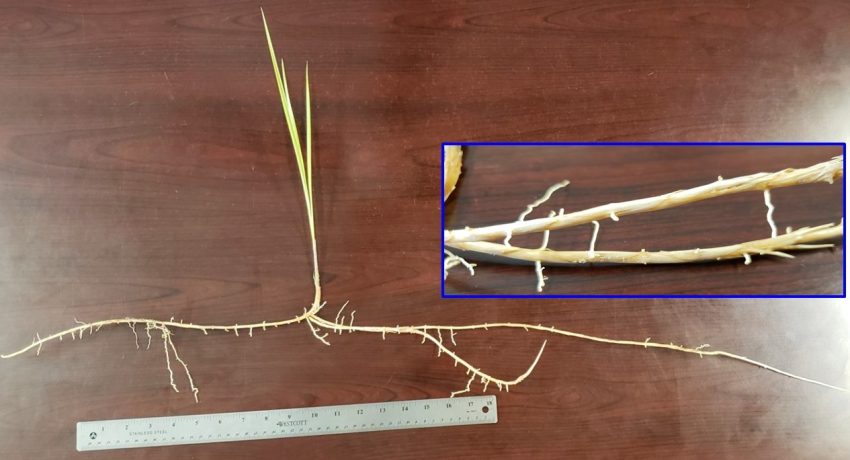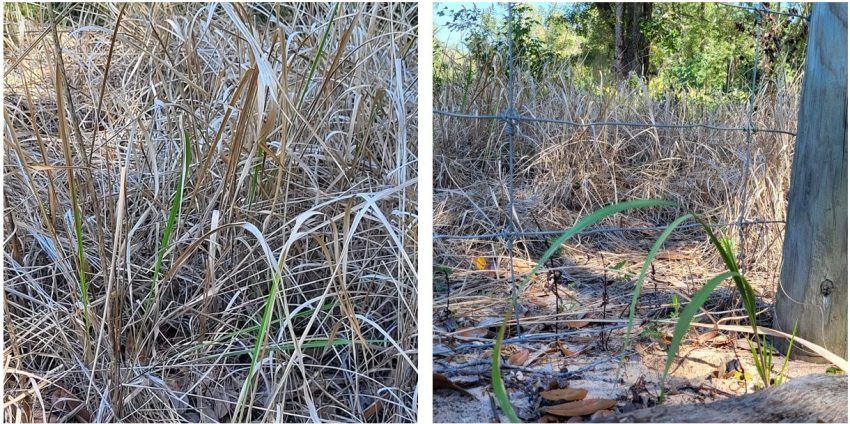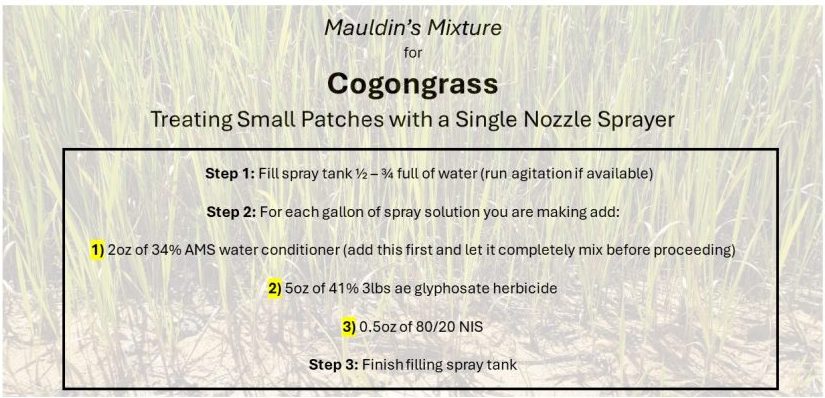Without question, Cogongrass is the most troublesome invasive plant that I (and my clients) deal with. Here in Northwest Florida, we have a lot of it, and it is very difficult to manage. With that in mind, I write about cogongrass control with some frequency. If you –follow Panhandle Ag e-News and/or Panhandle Outdoors you’ve probably seen much of what’s included below before. That’s ok, a refresher never hurt anyone and, unfortunately, there are plenty of folks out there who are just realizing that they have a cogongrass problem.
It has been my observation that the difficulty of management and the corresponding limited early success often led to frustration and ultimately a loss of interest in control efforts on the part of landowners or managers. This is the absolute worst-case scenario, as diligence over time is paramount to successfully managing cogongrass. With all this in mind, optimizing the impact of the initial control effort is crucial both in terms of biology (efficacy on the plants) and psychology (keeping the landowner encouraged and motivated). If you have cogongrass to fight, take every step you can to get the absolute best results out of every treatment, especially the first one.

Cogongrass has no visible jointing, segmentation, or branching above ground. However, in the top 3-6′ of the soil it forms a dense mat of white, fleshy, clearly segmented rhizomes which are a key identifying feature. Credit: Mark Mauldin, UF/IFAS
–
The following is a discussion of some of the steps you can take to maximize the efficacy of your control efforts.
–
1) Timing Matters
Cogongrass is best treated with a fall-spring, one-two punch. Mid-summer and mid-winter treatments are not advisable. Based on my experience, the ideal time to treat cogongrass is October through November, before first frost, with good soil moisture. Spray now, during the fall window, and be prepared to spray again in the spring when you have at least 12 inches of green leaf and good soil moisture. I have mentioned “good soil moisture” twice… what exactly does that mean? It means there is sufficient moisture in the soil that the cogongrass is not experiencing any level of drought stress. Herbicide applications made to “stressed plants” are generally less effective than are applications to made to “happy plants”. It is very hard to see symptoms of drought stress in cogongrass. Generally, you need to look at the plants around the infestation for clues. If any of the plants in the surrounding landscape look wilted or crispy during the heat of the day, it’s probably best to delay herbicide applications. This concept is worth noting primarily because here in the Central Ppanhandle we tend to be dry during both the fall and spring application windows. I am writing this article on 10/9/24. At my house we’ve not had a drop of rain since Hurricane Helene came through on 9/27 and my trusty weather app say not to expect any for the next 10 days. While it will vary greatly by location and soil type, it looks to me like we are running out of hurricane moisture, and it is rapidly becoming too dry to spray. All this boils down to the fact that you need to be ready take advantage of the situation and spray when soil moisture is adequate.
With that one-two punch successfully delivered, you should see significant reduction in the size of the infestation by this time next year. Keep repeating the fall-spring process until you can no longer find any cogongrass. Be sure to look carefully, as the infestation retreats it can be easy to miss the less robust and more scattered remnants mixed in with other vegetation. These remnants need to be sprayed, if not rapid regrowth and reinfestation will occur.

Close examination of this cogongrass patch shows regrowth occurring in the patch and growth that was apparently missed by the prior herbicide application. Both of these scenarios are common and help to illustrate why it is important to scout diligently and be prepared for re-treatments. Credit: Mark Mauldin, UF/IFAS
–
2) Coverage & Leaf Area are Crucial
To make the most out of each treatment you must maximize the amount of chemical you get into the plant. This is done by getting thorough coverage on as much green leaf area as possible. Make sure you have plenty of green leaves (at least 12inches) and spray them like you’re painting a wall. You don’t want runoff, but you want every square inch of leaf covered with spray. Don’t mow or burn for at least 30 days after you spray. Cogongrass can be hard to spot when it is growing mixed with other grasses/green foliage. Look diligently to find the edge of the patch and then spray 10 feet past the known edge on all sides of the patch.
–
3) Get the Spray Mixture Right
Notice, I didn’t say pick the right chemical. There’s more to it than that. The following recommendations will be based on managing cogongrass with the active ingredient glyphosate. (Imazapyr is also very effective on cogongrass, but due to its soil activity it is inherently more complicated to use and ensure the safety of desirable plants near the treatment area. I am not comfortable recommending imazapyr without first seeing the site where it is to be applied and discussing the risk to other vegetation with the landowner. Glyphosate must enter a plant through a green leaf making it much easier for applicators to ensure the safety of desirable vegetation.)
Generally speaking, the efficacy of glyphosate will increase if a water conditioner and surfactant are included in the spray solution. To clarify, this means there would be three separate products going into the spray tank – one herbicide and two adjuvants. The preferred water conditioner would be a 34% liquid Ammonium Sulfate (AMS) product and the surfactant would be an 80/20 Non-ionic surfactant (NIS). These products should be available anywhere ag chemicals are sold (not the garden center at a big box store) under many different name brands. Selecting a glyphosate product can be somewhat confusing, simply because there are so many different products on the market. The product amounts listed below are based on a 41%, 3lbs acid equivalent (ae) per gallon glyphosate product. This is a relatively common formulation, but there are many others available. All can be effective; it is just a matter of value and correctly adjusting the rate to match the formulation you are using.
For a broadcast application using a tractor mounted sprayer or other similar equipment, mix a spray solution such that 1 gallon of 41%, 3lbae glyphosate herbicide is applied per acre. Ideally this would be delivered in 10-20 gallons of water (be sure spray equipment is properly calibrated). Add a liquid AMS water conditioning product at 2% v/v before adding herbicide to the tank. Add a non-ionic surfactant (80/20 NIS) at 1qt per 50-100 gallons of spray solution after the herbicide has been added.
I understand that nobody likes to have to deal with all the numbers, especially the various formulations of glyphosate. Unfortunately, that’s just part of it… There are so many different products out there that the numbers are necessary to communicate the recommendations in a way that is widely applicable. Please don’t hesitate to contact me (850-638-6180) or your local UF/IFAS Extension Agent for assistance sourcing vegetation management products or tailoring the recommendations to match the specific products you have on hand. The most important thing is to get the mixture right and make the application be as effective as possible.
More than any other weed I manage, Cogongrass penalizes the applicator for not paying attention to the details. It is a very difficult plant to control; partial efforts are essentially a waste of time. I encourage you to take the extra time, effort, and expense and make the most of every application.
–
Further Reading on Cogongrass Control
–
COGONGRASS (IMPERATA CYLINDRICA) BIOLOGY, ECOLOGY, AND MANAGEMENT IN FLORIDA GRAZING LANDS
–
Center for Aquatic and Invasive Plants – Imperata cylindrica
–
Biology and Control of Cogongrass (Imperata cylindrica) in Southern Forests
–
Cogongrass – Now’s the Best Time to Start Control
–
- Peanut Maturity Update – 10/9/25 - October 10, 2025
- Fall Can be a Great Time for Vegetation Management - October 3, 2025
- Peanut Maturity Update – 9/25/25 Edition - September 26, 2025

